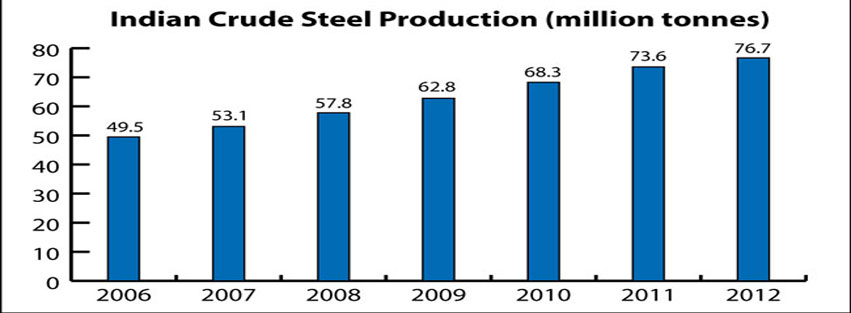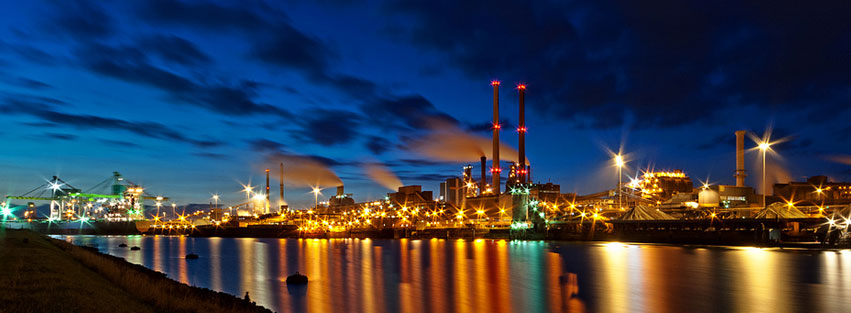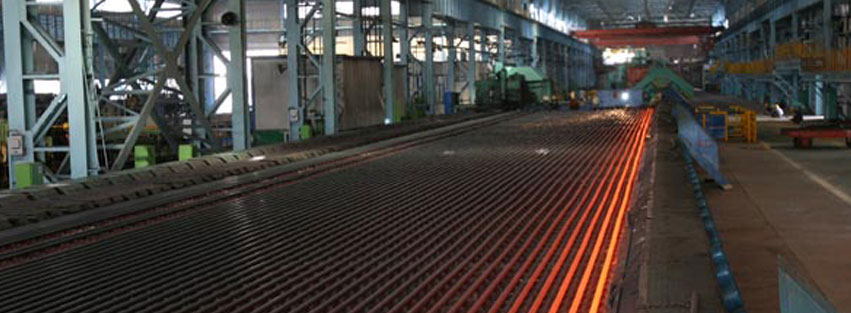India’s economic growth is analysed by the growth of Indian Steel industry. Demand for steel is an indicator of economic development. Steel continues to serve most of the industries and India occupies a larger place in the global steel market. Higher demand for steel from all traditional sectors has boosted growth. In 2013, the growth of steel was 1.8 per cent whereas in 2014, its growth is 3.3 percent and it is expected that the growth may be up to 4.5 per cent in the year 2015. The growth of finished steel products have also reached 5.6 per cent in 2014. Steel has been manufactured globally and does not face any barriers in trading across other countries.
Growth and improvements in steel sector

During Independence, India just had a small Iron and steel industry producing about million tonnes of steel. Later, the government showed interest in this industry and improved the standards of steel production. In 1990’s many public and private sectors were established in the steel production. Major improvement happened for the steel sector like Export restrictions were removed, Import tariffs were reduced to a great extent. Foreign investment was also encouraged and Steel industry was the high priority industries for foreign investments. Impressive development of Steel industry has induced the government to come up with National Steel policy that aimed in establishing roadmap and framework for the development of Steel in India.
Performance of steel industry
The growth of finished steel production grew at the rate of 8 per cent. The consumption rate of steel grew by 11 per cent which is higher than the previous years. The imports and export of steel is growing steadily. In last 10 years imports have grown by 24.49 per cent and exports by 2.16 per cent. It is to be noted that there is no single entity that dominates the steel sector as a whole or its major product sectors. The growth of steel sector is rapid and the production growth was about 8 per cent in last 10 years. Steel comes in different forms and the demand for each form is different. Bars and rods is a major part of the total steel production. Structural form of steel is undertaken by SAIL and RINL which has contributed to 36 per cent of total production. Hot rolling coils, plates, sheets, CR coils; sheets are also types of steel in India that contributed to the performance and growth.
Various steel companies have plans to expand their capacity in the coming years. If their plans materialize, the steel market will see significant increase in most product categories. It is to be noted that the individual contribution from each company has been growing, with multiple projects; each will have significant growth in the whole industry. Most of the advanced countries has created free business environment, transparent laws and strict adherence to the law to make the system work at the maximum possible efficient. Likewise, similar rules and regulations should be implementing in India to improve the efficiency.
Steel Industry in India

The Tata Iron and Steel Company (TISCO) was established in 1907.which is the starting point of modern Indian steel industry. Afterward a few more companies was established in India namely Mysore Iron and Steel Company and Steel Corporation of Bengal.
in 1947,India had a small steel and iron industry with production of about a million tonnes (mt).and the government was mainly focusing on developing basic steel industry ,where crude steel constituted a major part of the total steel production. Many public sector unit were formed and they had a dominant share in the production of steel.
Steel production processes

Blast furnace:it is also named as basic oxygen furnace. it is the a process in which the iron ore is converted into liquid form of iron. iron produced by this method contains high amount of carbon and other impurities. this iron is called pig iron. To make steel products from pig iron it is further processed into BOF(basic oxygen furnace) where its carbon content and other impurities are burnt or removed through slag separation. the main input for the blast furnace is iron ore and coal. basic oxygen furnace is also known as oxygen furnace because oxygen is the only fuel used in this process.
Electric Arc Furnace : in this process the sponge iron is remelted , melting scrap is main inputs to produce finished steel. It uses 400-500 kWh/ton of electricity. ISPAT ,ESSAR and the Jindal group uses this technology.
COREX or Cipcor Process: it is an advance process of making steel. Though few use this process, in melting work . the non-coking coal is used directly for the melting work and it also makes it possible to use lump ore and pellets as inputs. These two advantages allow steel producers to eliminated coking plants and sinter plants. Purpose of coking plant is to convert non-coking coal into more efficient fuel and purpose of sinter plant is purify lump ore or pellets for further processing. Basic inputs to COREX are iron-ore and coal. Jindal Iron & Steel Company (JISCO) uses COREX technology to produce finished steel.
Induction arc furnace(IAF): it is a most advance process in the production os steel.\it also uses electricity as fuel .it is the environment friendly and efficient way to produce steel but its lack of refining capacity requires clean product as its inputs. small steel companies use this technology
Steel Plants in India
Tata Iron and Steel Company (TISCO)::TISCO is located at Jamshedpur at the joining of the Subarnarekha and the
Kharkai rivers.it is along the Nagpur-Kolkata rail line in Singhbum district(Jharkhand) it is the private sector and second largest steel plant in India. In 1907 the famous industrialist J.N tata built up this plant. It started producing pig iron in 1908 and steel in 1911.
The plant has basic open hearth furnaces, acid Bessemer conveners and basic tilting open hearth furnaces for the manufacture of pig iron and steel. With the help of electric furnaces they are making high grade carbon steel which is used for structural fittings and tin plates. Besides, it also produces acid steel for making railway wheels, tires and axles, bars, rods, sheets, corrugated sheets, wires, steel castings, nails, nuts, bolts and tinplates. Special alloy steel produced by the plant is used for making bullet-proof armour plates and for armour-piercing bullets. The plant has been working between 85 and 90 per cent of its rated capacity.
Visvesvaraya Iron and Steel Plant:Visvesvaraya Iron and Steel Plant is located at Bhadravathi, India. It is 260 km from banglore in north west direction it is the part of steel authority of India limited. it produces alloy steel and pig iron. On 18 Jan 1923, the Mysore Iron Works was started by Sir M Visvesvaraya the plant covers the area of 3.8 square kilometres. the number of person working in this plant is 2467 as on 01.09.2007. The company had technical collaboration with M/s. Bohler Brothers & Co
